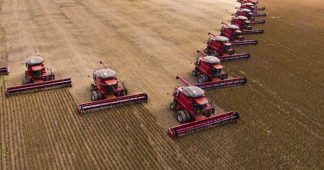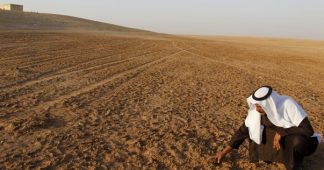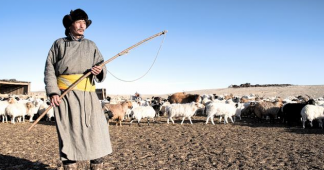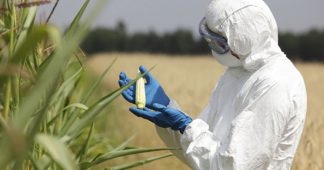By Maroosha Muzaffar
Mavlon Pulodov’s tall quinoa stems sway in the wind. Unlike farmers in the Andean countries of South America — home to the crop for millennia — this agricultural scientist is 9,000 miles away in Tajikistan. Pulodov is thrilled because he’s managed to grow the superfood after years of trying. Together with the Swiss arm of Catholic aid group Caritas, he’s helping farmers cultivate quinoa on a 100-hectare strip in southern Tajikistan, which is expected to yield its first harvest this year.
Rich in protein, minerals and vitamins but free of gluten, quinoa has become a popular health food worldwide in recent years. But as recently as 2014, Bolivia and Peru alone produced 80 percent of the crop, according to the Food and Agriculture Organization (FAO). Now more and more countries with no tradition of growing quinoa are racing to embrace it. In 2010, only 40 countries cultivated any quinoa, but today more than 100 countries do, and Bolivia and Peru’s global share has dropped to 65 percent.
The booming demand for the superfood — global production of quinoa between 2009 and 2019 tripled from 75,000 to 230,000 metric tons — is only one part of the equation. A rare resilience to different conditions is allowing researchers to experiment with variants of the crop in diverse locations, turning quinoa into a potent agricultural product that can survive climate change. The crop that originated in the cool, tropical mountains of the Andes is now being cultivated in hot and dry Saudi Arabia; in Central Asia’s Kyrgyzstan, Tajikistan and Uzbekistan; and in the limited sun of Scandinavia’s Denmark and Sweden.
“QUINOA IS EXTREMELY RESILIENT TO ENVIRONMENTAL STRESSES AND HIGHLY NUTRITIOUS.”, ISMAHANE ELOUAFI, PLANT GENETICIST
The global expansion of quinoa is also reflected in the crop’s price. It tripled between 2008 and 2014 to $3 a pound but has since crashed to $0.75 a pound. While not great for farmers, the lower cost does address a bigger concern: that quinoa had grown too expensive to eat for the very South American communities that have relied upon it as a staple for centuries.
“Quinoa is extremely resilient to environmental stresses and highly nutritious,” says Ismahane Elouafi, director general of the Dubai-based International Center for Biosaline Agriculture (ICBA), which is developing strains of quinoa that can grow in extreme climates. “So it helps to solve food insecurity and undernourishment, especially in water-scarce regions where agriculture is the main source of livelihood for rural populations.”
A key moment in the global recognition of the crop’s potential as a climate-resistant superfood came in 2013, which the FAO declared the International Year of Quinoa. But researchers in different parts of the world had been wowed several years earlier. Chinese researchers first experimented with quinoa in the late 1950s, while their counterparts in the U.K. did so in the 1980s.
Still, only eight countries in all grew quinoa by 1980. It’s only with the boom in demand for the crop as a superfood this century, combined with rising concerns about climate change and food security, that more and more countries have turned to quinoa cultivation. “Taking into account climate change,” says Pulodov, “we can safely recommend this crop in various marginal zones as a drought-tolerant crop.”
Take the Aral Sea region in Kazakhstan and Uzbekistan, where the FAO estimates at least 2 million people are undernourished, 53 percent of children have vitamin A deficiency and 24 percent of adults are deficient in zinc. High levels of soil and water salinity in the region make it hard for most major crops to grow. Not so with quinoa, which the ICBA has found can survive there. Uzbekistan harvested its first quinoa crop in 2018. Supported by the Islamic Development Bank, the ICBA has introduced the crop in Kyrgyzstan and Tajikistan too.
“Its genetic diversity and adaptability to different agro-environmental conditions make it stand out from other crops,” says Dr. Kristina Toderich, a Tashkent-based plant scientist.
In Tajikistan, where 93 percent of the territory is mountainous, the crop can be grown in the rain-fed land from different heights ranging from 530 to 4,000 meters above sea level, says Pulodov.
Meanwhile, in Egypt, at least 2,000 farmers are growing quinoa with the help of foreign aid agencies based in the U.S., Sweden and the Netherlands. And in Scandinavia, scientists who were initially worried that the crop wouldn’t work there because of the short vegetation window have developed a variant that fits their schedule.
With climate change increasingly turning rain-fed agricultural land into areas where most crops can’t grow, quinoa’s resilience and adaptability “can help to ensure agricultural production in such environments,” says Elouafi. It’s little surprise that a conference the ICBA held in Dubai in 2016 to explore what researchers could do to spread quinoa in “marginal environments” drew 150 delegates from around the world.
So can quinoa be grown anywhere? No, many countries don’t have research and development capabilities to develop strains of the crop suitable for their environment, cautions Elouafi, and what works in Sweden won’t work in Saudi Arabia. Also, owing to the price drop, some analysts worry that farmers will try to rush and grow quinoa in fallow land to make up for lower per-unit margins, thereby hurting the long-term fertility of the soil. And in most countries where farmers are now beginning to grow quinoa, the crop is yet to make its way into the mainstream diet, so information campaigns are also needed.
But Pulodov likes to remind farmers that a century ago tomatoes and potatoes weren’t a part of the diet in Tajikistan either. Now, they’re staples. So don’t be surprised if quinoa pilaf makes its way from chic cafés to the average dining table in Central Asia one day soon.











